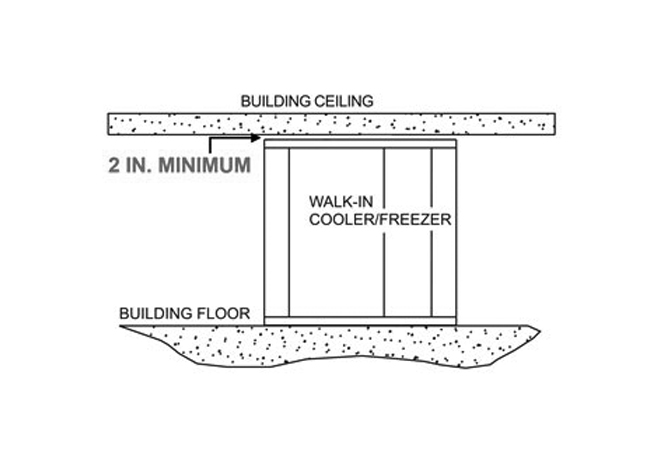When considering a walk-in cooler or freezer for your business, it's crucial to address several essential questions to ensure you make an informed decision that meets your needs. This article gathered three of the most frequently asked questions to provide insight and clarity.
What Are The Average Energy Costs Of Walk-In Coolers And Freezers?
Energy costs are at the top of the walk-in cooler and freezer FAQs list for any business owner. It’s tough to nail down exact costs due to the many variables involved, but the charts below provide an idea based on several standard sizes. Costs are based on a national average of $0.1304 per kw/h.
Walk-In Coolers
| Walk-In Size (ft) With 8'7" Height | Energy Consumed(kWh) | Energy Consumed @13.04 cents/kwh monthly |
|---|---|---|
| 6 x 6 | 1.08 | $68.71 |
| 6 x 8 | 1.28 | $81.15 |
| 8 x 8 | 1.51 | $95.82 |
| 10 x 8 | 1.70 | $108.17 |
| 10 x 10 | 1.96 | $124.10 |
Walk-In Freezers
| Walk-In Size (ft) With 8'7" Height | Energy Consumed(kWh) | Energy Consumed @13.04 cents/kwh monthly |
|---|---|---|
| 6 x 6 | 1.17 | $83.78 |
| 6 x 8 | 1.36 | $97.24 |
| 8 x 8 | 1.60 | $114.10 |
| 10 x 8 | 1.81 | $129.21 |
| 10 x 10 | 2.04 | $145.97 |
As noted, these estimates will vary with your application and are based on these general assumptions:
- Walk-in coolers and freezers using four-inch-thick polyurethane insulated panels
- Walk-in coolers based on 35°F temp, floorless, 90°F ambient, 16-hour runtime, 8'7" height with one 36" X 72" door, heavy usage
- Walk-in freezers based on -10°F temp with floor, 90°F ambient, 18-hour runtime, 8'7" height with one 36" X 72" door, heavy usage
- Energy calculations based on an average business electricity rate of 13.04 cents/kWh (https://www.saveonenergy.com/business-energy/)
- Refrigeration system sized to handle the BTU/hr load of the walk-in selected (assumes use of refrigeration system sizes offered by Refrigerated Solutions Group)
How Big Should My Walk-In Cooler Be?
The next item in our list of walk-in cooler and freezer FAQs concerns sizing. We’ve seen that many factors determine operating costs, and it’s the same with walk-in dimensions.
Firstly, assess the type and size of products you'll store. A general guideline is that one cubic foot can hold about 28 lbs. of food. You should also anticipate future business growth when deciding on dimensions to avoid hindering expansion or incurring unnecessary operating costs. Thankfully, a wide range of sizes is available, ranging from 4 ft. x 6 ft. to massive refrigerated warehouses.
If space is limited, consider an outdoor walk-in, but note additional features required, such as a vinyl roof and rain hood. Factory-assembled walk-ins can be a convenient outdoor solution, as they arrive ready for installation at your location.
The interior organization matters, too. Use shelving kits strategically to maximize space, ensuring aisle spaces of around 40 inches for product loading.
 Strategically placed shelving kits maximize space and maintain walk-in dimensions.
Strategically placed shelving kits maximize space and maintain walk-in dimensions.
Remember to plan for the refrigeration system, which impacts overall size. Choose between packaged (combined condensing unit and evaporator coil) or remote systems. Allow adequate space for airflow and service access. Leave two feet of clearance for ceiling-mounted systems, while for remote systems, allow two inches between the walk-in and building ceiling.
 Ceiling-mounted refrigeration needs 2 feet of clearance from system to building ceiling.
Ceiling-mounted refrigeration needs 2 feet of clearance from system to building ceiling.
 Remote systems need 2 inches between walk-in ceiling and building ceiling for installation.
Remote systems need 2 inches between walk-in ceiling and building ceiling for installation.
What Is The Best Temperature For A Walk-In Cooler?
Maintaining the right temperature in your walk-in cooler or freezer is essential for food preservation and safety. Aim for 35°F for coolers and -10°F for freezers to ensure optimal conditions. These temperatures align with federal guidelines to prevent bacterial growth and maintain food safety.
Avoid sudden temperature changes, which can compromise food quality and safety. Allow hot foods to cool before storing them and be cautious not to expose delicate items like fruits and vegetables to excessively low temperatures.
Understanding storage limits and consulting federal guidelines can help you safely store various food items. You should also ensure your refrigeration system is appropriately sized to maintain the required temperatures.
To improve efficiency, minimize door openings and consider using vinyl curtains to retain cold air. Additionally, temperature monitoring options can help you stay informed about fluctuations and adjust as needed.
For Additional Questions
Adding a walk-in cooler or freezer to your business requires some introspection. Energy costs, size and optimal temperature are just a few of the questions you should ask before committing to such a significant purchase. Seeking guidance from a foodservice equipment dealer or manufacturer for your application is always a good idea.
For assistance with your next walk-in project, please call us at 800-647-1284 or click one of the links below.



